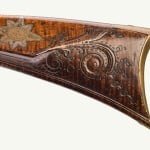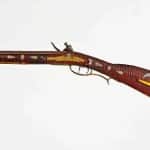By Ronald G. Gabel
Why do people collect “Kentucky” rifles? Why are they considered America’s rifle? How were they used? Why are they called “Kentucky” rifles? Why are they historically important? Why are they considered one of our countries only true art forms?
American people have always been collectors. I have often heard it said if three or more of anything are created someone will try to collect them. I never totally believed that statement until I met a person who collected toilet paper from around the world.
But when a person buys an outstanding and unique item, researches its background, investigates its history and verifies its authenticity; then he begins to uncover significant details about the piece, its maker and its contribution to our nation’s history.
Firearms have always played a significant part in the worlds history, and in the history of our nation. When a collector holds a firearm in his hands and is able to say when, where and by whom it was made, how and where it was used and understands it is one of few remaining examples in existence then, and only then, is he able to make history come alive through his collection.
Patriotism, romance, great achievements and legends of characters in our early history should forever be kept alive in the eyes of our American youth. Information gathered from articles in personal and museum collections helps our youth develop a greater appreciation of America as a country and a greater respect for its history, our institutions and our form of government.
Let’s take a step back in time and let our minds wander back to the beginnings of this country, envisioning the early days of the pioneers with their so-called “Kentucky” rifles. No other item of memorabilia proudly passed down from one generation to another is more deeply rooted in the history of our nation.
The first pioneers into this country were explorers soon followed by the traders. The most important tool available to these early pioneers, and later settlers, was their rifle. These pioneers soon discovered firearms they brought with them from Europe were not suitable for this new country.
Wherever these men traveled they developed opinions about the shortcomings of their weapons and considered ways to improve them. Guns slowly evolved to have open sights that were more useful in dark forests, barrels started to get longer for more complete burning of powder, calibers were made smaller in diameter to use less powder and lead and so bullets could be loaded into the barrel using a greased patch, ramrods were wooden sticks for faster and quieter loading. The use of a patched ball in conjunction with all these other improvements resulted in a new, remarkably accurate, rifle equally effective with hostile Indians or game.
Craftsmanship in these rifles in their Golden Age was superb and its makers produced a lavish product to be forever cherished by its owners, who at the time of its creation was usually a fine marksman. Stocks were made of selected curly maple, the finest obtainable, and were generally made more slender with thinner butts and smaller wrists. Carving of these stocks became more profuse, more finished and more beautiful in design. Some rifles had relief-carved stocks of exceptional workmanship; many used interlacing scrolls while others were carved in geometric or other patterns. Inlays increased, and these were often more elaborately engraved to a degree approaching perfection. The brass patchbox received more attention, becoming a work of art in itself with many interesting variations in style, cutouts and engraving.
Obviously these rifles are extremely rare today due to the hard daily usage to which frontier conditions subjected them. Frontiersmen placed their lives and the lives of their families upon their rifle, so it generally received the very best of care possible under the conditions of its use.
In the mid-18th century, prior to the American Revolution, the vast unexplored area west of the Cumberland Mountains was referred to simply as KENTUCKY. The frontiersman’s very existence often depended on his rifle and his ability to use it. Since men who ventured into the Kentucky wilderness quickly became household legends across the land their rifles were often referred to as Kentucky rifles in news clippings and advertisements published before the revolution.
But the vast numbers of settlers were unfamiliar with the term until after the famous 1812 Battle of New Orleans in which riflemen from KENTUCKY overwhelmingly won the battle. After that battle there appeared a ballad that swept the country entitled ìThe Hunters of Kentuckyî in which American sharpshooters were referred to as the men from Kentucky with their “Kentucky Rifles”. This popular ballad was sung frequently all over the land in the 1820s, í30s and í40s. The nickname stuck and the world over even now refers to the American rifle as the Kentucky rifle.
Collectors speculate on exactly where the American Longrifle was actually born. It was, in fact, not born in any particular area; it evolved wherever the rifle was being used. The state where the majority of early gunsmiths have been documented was Pennsylvania so that some refer to it as a “Pennsylvania Rifle”. Europeans tend to refer to the arm as the American Rifle or American Longrifle while others simple refer to it as a “Longrifle” or “Squirrel rifle”. Call it whatever you prefer, it remains a unique part of American culture, art and ingenuity.
About two hundred and forty years ago in our country shooting was the national pastime. For entertainment pioneers shot guns much like today they “shoot” golf, play baseball, football, basketball and other popular sports. Shooting at a turkey or deer to feed their families was part of the daily occupation of those families who lived on the frontier and in the backwoods. In those days men were proud of their fine hunting rifles, considered around the globe as the most accurate in the world, and no crossroads tavern could be successful without facilities for regular tests of marksmanship. Rarely did any public gathering of men for any purpose disperse without a shooting match. It was at these informal matches that national reputations were made and legends were born. The most skilled marksmen often spent their life savings to own the most accurate and artistic rifle possible to showcase their skills.
So it was these early American pioneers that made possible the birth and development of one of our nations’ only true art forms, the all-American “Kentucky” rifle. This rifle reflects the finest example of frontier art and craftsmanship. Fine early American furniture, silver, paintings, pewter, pottery, clocks etc. all, it can be argued, were extensions of European art and design. The “Kentucky” rifle was conceived here and made by thousands of early gunsmiths, blacksmiths, farmers and other talented frontiersmen. Many persons living today will discover, when they develop their family trees, these gun makers were their ancestors. Many families are at this time seeking out existing rifles known to have been created by their ancestors to pass along to their children. Relatively few of these pieces of history remain today, and as these examples find their way into museums, are lost to fires, floods, storms and other tragedies, fewer will exist in the future. As their supply diminishes their value will increase until, as in many countries, they will be impossible for the average person to own.
Few people today have the opportunity and privilege of preserving these items of Americana which represent the art and the early struggles of our forefathers. These fortunate few hold in their hands the key to our existence as a nation, the purest form of early American art and history itself. Take a look at these rifles showcased in major museums around the world and over the fireplaces of our finest early American furnished homes. In many cases you will be forced to admire their beauty.
About the Author
Ronald Gabel has been an avid collector for 55 years. He currently is a Consulting Expert for James D. Julia Auctions in Fairfield, Maine and Man at Arms for the Gun Collector publication. Ronald is also the editor of the Pennsylvania Antique Gun Collectors Association Bugle newsletter and has been the editor of the Kentucky Rifle Association bulletin for 40 years. Ronald currently holds the position of Vice-President of the Pennsylvania Antique Gun Collectors Association. His past positions have included President American Society of Arms Collectors, President Kentucky Rifle Association, President Kentucky Rifle Foundation, and President and curator JHS Pennsylvania Longrifle Museum.








Related posts: